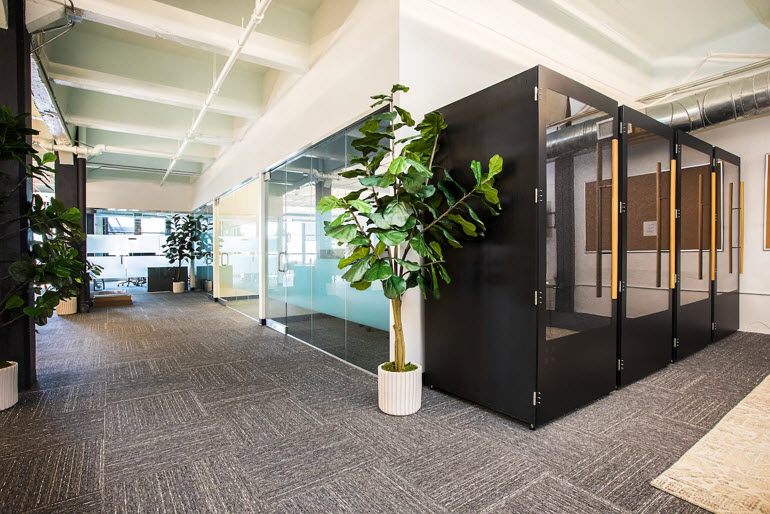Sound masking is an increasingly popular workplace solution for improving privacy and productivity, helping employees focus and work more efficiently. It is often implemented in open floor plans or call centers in order to reduce speech intelligibility, ambient noise levels, and distractions from speech intelligibility or any potential threats. Read on and learn more about these new, fascinating systems.

Cost
Noise distractions in large open offices can be particularly challenging to deal with, making concentration difficult for some employees. While others may be able to ignore office machines humming away in the background, phones ringing off, and overheard conversations; others will find it impossible to work without these disruptions affecting them and potentially making the ill (source: www.sciencedirect.com/article/soundmasking). These systems provide a solution by blocking these interruptions out completely while improving acoustic comfort and maintaining privacy for workplaces of various industries.
Many acoustic treatments exist to decrease noise distraction, with masking systems often being the least costly option available when compared with architectural upgrades or environmental control methods. Organizations that benefit from increased comfort and speech privacy often find that initial investments in these systems outweigh their eventual returns.
Traditional sound masking systems utilize large paint can-shaped loudspeakers installed near the ceiling to broadcast a uniform background noise into a space. Such systems require considerable design and installation time in order to ensure that masking sound does not spill over into unwanted spaces; such systems consume significantly more energy than Qt systems with fewer speakers.
Using noise generators with white noise is a popular option. Just so you know, white noise has many frequencies that sound similar to television static – soothing to most. This process uses a uniform tone that resembles gentle airflow and can be played through speakers installed in the ceiling to blend into the workplace ambiance.
No matter the industry you operate in, whether it is law firms seeking to maintain client confidentiality or educational institutions seeking to enhance acoustic comfort – there are companies that offer customized sound masking solutions designed specifically to suit each needs and cost-effectively meet them. Simply search “how much does a sound masking system cost?” and look for one in your area. Call them to ask any questions as I’m sure they’ll be happy to assist you.
Benefits
Though the upfront costs for sound masking may seem excessive, its benefits and potential returns make it a worthwhile investment. Many businesses report increased productivity, reduced data entry errors, and enhanced speech privacy thanks to installing such systems. Most systems include music or emergency evacuation paging at no additional charge which further decreases overall installation costs.
Noise distractions in modern workplaces present one of the greatest challenges. Employees are regularly interrupted by chatty co-workers, ringing phones, and other office noise; even one distraction can cause their minds to drift off-task for up to 23 minutes before returning back to task again.
Sound masking provides a solution to these issues by eliminating personal conversations and minimizing co-worker interruptions with comfortable background noise, so workers can focus on work uninterrupted by interruptions from colleagues.
Sound masking may also be able to improve acoustic comfort in areas with low occupancy. When spaces are vacant, they may feel disquietingly quiet and unpleasant – due to an absence of an acoustic “hushing curve” which would normally muffle speech and other sounds that would normally be heard.
It may seem counterintuitive, but in actuality, it works by adding background noise that actually creates the appearance of silence in any given space. This is because the added noise does not cancel out or block out distracting sounds but simply makes them less intelligible and disruptive – similar to how white noise machines create a constant hum that drowns them out and reduces disruptive sounds.

Installation
These systems create a soft background noise level to reduce auditory distraction in workplace environments, called ambient noise. The levels vary to mimic the natural ambiance of each space through speakers hidden in the ceiling – helping workers maintain concentration while decreasing interruptions from outside and adjacent offices.
According to this link – this technology can also prove invaluable in healthcare environments where paging and public announcements are commonplace, helping create a more relaxed environment for patients and staff alike. Reducing noise levels within medical rooms also contributes to creating an ideal experience.
Once speakers are in place, they can be adjusted using the control unit to create the ideal atmosphere in each space. Open areas may benefit from higher volume settings during times of high activity; more private settings should keep masking volumes low at all times.
Choose a professional sound masking installer to ensure that the appropriate settings are in place for your business. A knowledgeable installer can advise on which system best meets you’re zoning and ceiling type needs; in addition to suggesting an optimal number of speakers based on room size.
Maintenance
Working in an open office environment can make it hard to focus, with conversations with other workers often interrupting one’s concentration and leading to lower worker productivity, mistakes, and stress levels. This has serious repercussions; such as decreased worker productivity, mistakes, and greater stress levels for everyone involved.
Sound masking systems can help reduce distracting conversations from being audible in any one space, creating a more productive and less distracted workplace. Workers also enjoy being able to engage in confidential discussions subject to data protection regulations without fear of them being overheard by coworkers.
At the core of any sound masking system lies its generator, which produces non-repetitive digital sounds resembling softly blowing air. These sounds are then carried to speakers located in ceilings aimed upward for even distribution and connected with audio equalizers that enable adjustment based on space-specific acoustics characteristics.
Based on client needs, sound masking systems may also include overhead paging and music capabilities. These features are typically controlled via user-accessible controls that are password protected; as with masking sounds, their parameters should also reflect expected occupancy density in each zone and accommodate holidays accordingly.
Sound masking systems should typically be tuned by a certified technician once construction has been completed and mechanical systems have reached daytime operating levels. They will measure masking sound at ear height in each zone before adjusting their settings to meet desired masking curve. So don’t wait – call in the professionals, today.
